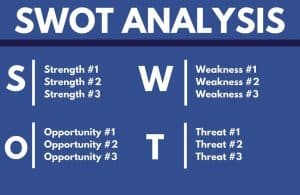How do you see competitors in your industry? Do you see them as a threat, a motivation, or an information bank to learn from? Hopefully, the important competitor analysis tools provided in this post will help you use your competitors to serve your customers better.
What Is Competitor Analysis
Competitor analysis is a way companies in an industry get to see the full picture, which is the strength and weakness, of their current and potential competitors. So, it helps companies realize opportunities and strike decisively against their competitors. Clearly, it is handy for every business, no matter the size or the stage. That is small business owners, big business cooperatives, and start-ups.
What Is Competitor Analysis Example?
They are:
Brand Recognition. The proportion of your target market that is aware of your competitor’s brand.
Costs. Using financial documents to estimate the costs of a competitor’s products.
Products.
Customer Service.
Capabilities.
Financials.
culture in the workplace.
Intellectual property rights.
Why Is Competitor Analysis Important?
The goal of a competition analysis is to understand your rivals’ strengths and shortcomings in relation to your own, as well as to identify a market gap. A competition analysis is vital since it will assist you in determining how to improve your own company strategy.
Types of Competitor Analysis Framework
There are different types of competitor analysis frameworks that you can use for effective competitor analysis in your marketing strategy. And these frameworks have their differences and individual peculiarities that make them more effective in different marketing conditions. Let’s look at them and know when it’s best to apply them.
-
SWOT Analysis:
SWOT stands for Strength, Weakness, Opportunities, and Threats. It’s a popular and easy framework used by firms to analyze internal and external factors that can affect their business. The internal factors being strengths and weaknesses and the external factors being threats and opportunities. The constituents of each component of SWOT analysis are organized based on hierarchy by companies. So, SWOT analysis of a company will look like the image below.
-
Porter’s Five Forces:
This type of competitor analysis framework has five components as summarized below.
-
Level of competition within the industry:
There can be an inverse relationship between the number and strength of your competitors to your market relevance. Your power to influence the market can diminish when you have more competitors with a better product than yours.
-
Supplier power:
If you have suppliers above you in your industry. How easy can they increase the prices of their supply? Clearly, the more the number of suppliers with quality products the more your alternatives. So, this could force them to cut down prices to attract customers.
-
Buyer power:
How much will it cost buyers to influence your price in the market? Obviously, if you have a large customer base whom you provide with an affordable quality product better than that of other rivals. It will be quite difficult for customers to dictate terms for you.
-
The threat of substitution:
If there are lots of options for your customers to choose from then they will likely choose the cost-efficient ones. For example, if they could DIY your products. Then they are likely to cut you out. So, you have to constantly strive to make your product among the few options available to them.
-
The threat of new entrant:
The cheaper, in cost and time, it is for new competitors to enter a market the easier they can become a formidable competitor and weaken your hold of the market share.
-
-
Strategic Group Analysis:
By applying this type of framework. You will be able to group companies within your industry based on their strategy in the market. Know the ones that possess more threat to you in the industry and how to deal with them. Then know the ones that are less threatening and keep an eye on them.
-
Growth Share Matrix:
The growth-share matrix categorizes products based on their growth potential and market share. They are the cash cows, the dogs, the question mark, and the cows. Hence you can use this tool to know the stand of a competitor’s product in the market and how to rival it.
How Do You Write a Competitor Analysis?
Begin with an overview of your competitors.
Perform market research to identify customer personalities and industry trends.
In a feature comparison matrix, compare product features.
Use a SWOT analysis to summarize your strengths and vulnerabilities.
What Is the First Step of Competitor Analysis?
The initial step in doing a competitive study is to identify your rivals. There are both direct and indirect rivals.
READ ALSO: MARKETING STRATEGIES FOR E-COMMERCE BUSINESS
Competitor Analysis Tools
Let’s check out some examples of important competitor analysis tools that will help you gather and analyze data about competitors in your industry. We’ve categorized them based on these 4 areas of specialization.
-
Competitor Analysis Tools for Social Media:
These tools enable companies to monitor their competitor’s social media presence. Examples are Sprout social, Phlanx, Social blade.
-
Competitor Analysis Tools for SEO:
Helps sites to discover keywords that drove the most traffic to the competitor’s site. And more than providing trending keywords they also provide data on SEO attributes like backlinks, organic, and paid searches. Examples are SEMrush, Ahrefs.
-
Competitor Analysis Tools for Content:
They help businesses in the analysis of a rival’s content. So, this could help them learn and make adjustments to their subsequent contents. Examples of the tools are Buzzsumo, Similarweb.
-
Competitor Analysis Tools for Ads, Emails:
Tools like isPionage help businesses monitor a rival’s paid ads. It helps in the analysis of multiple aspects of pay per click campaigns. Also, email analysis tools like Milecharts and Owletter are handy when businesses want to dig into their rival’s Email marketing.
How to Do Competitor Analysis
So, you now have an idea of what competitor analysis is all about. Now let’s guide you through easy-to-use steps for your competitor analysis.
-
Discover and Categorize Your Competitors:
This is the very first thing to do in competitor analysis. It involves you finding out your competitors and classifying them based on the type of competitor they are to you. A simple google search of keywords in your industry could help you with these. Other tools like SEMrush and Similar web will also automatically list your competitor’s websites when you enter your own website in the search field. Then, when you are done identifying; categorize them based on the type of competitor they are.
-
-
Direct competitor
Provides similar products to solve the same problem for the same consumer base.
-
Different solution competitors
Provides similar products to the same customer base but using a different technique.
-
Different customer competitors
Solves the same problem with a similar product but to a different customer base.
-
For a detailed and thorough analysis, it is advisable to get at least one competitor for each of the categories.
-
-
Company Information:
When you have discovered your competitors. Then, it’s time to do some digging on some information about them. This information includes
-
-
the company’s overview like the number of employees
-
their funding and estimated revenue and
-
customer base features.
-
You can get information on the company’s overview on their website or social media platforms. And for their funding and estimated revenue, you can dig something up from their media interviews and conference presentations.
-
-
Product Information:
You need to know everything about the product your company provides. For example, product features, pricing, and customer benefits. If they have an e-commerce platform check it out to get product information.
-
Customers’ Details and Reviews:
Customers’ detail like their geography helps you know your competitor’s target location. Their reviews let you know their sentiment. Tools like Awario and Mention will be handy to gather information about your competitor’s customers.
-
Marketing:
The information you should gather here is as follows.
SEO, social media presence, influencers and partners, content marketing, Advertisement. The competitor analysis tools will help you out with these. -
Use the Appropriate Competitor Analysis Framework:
Feed your garnered intel to the most suitable type of competitor analysis framework. Know the strengths and weaknesses of your rivals. Then act based on the result of your analysis.
Importance of Competitor Analysis
If you call it espionage. Fine. If you consider it an invasion of privacy. No comment. But it’s apparent that competitor analysis is important to businesses. And some of these importance are as follows
-
Identification of Threats and Opportunities:
This is the major importance of every competitor analysis. So, you recognize the strengths and weaknesses of your competitors after analyzing them. Hence, these strengths serve as a threat to you, so you need to adjust well, and the weaknesses an opportunity for you to strike at.
-
Increase Market Share:
If you are far low in ranking in your industry. Then, this is the long-run importance of competitor analysis. Realizing your customer’s taste from a competitor and fine-tuning it will have an impact on your market share.
-
Proper Channeling of Resources:
You don’t get to waste resources on low yield products or marketing strategy after conducting a comprehensive competitor analysis.
-
Increased Sales:
When you have a sizeable market share; your sales increase. Hence, this is another importance of competitor analysis.
Conclusion
I hope this post will help you use your competitors to serve your customers better.







